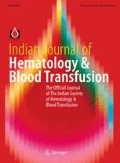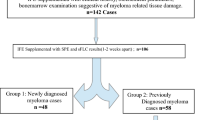Abstract
Introduction: High resolution electrophoresis (HRE) and immunofixation (IFX) of serum and urine are integral to the diagnostic work-up of multiple myeloma. Unusual electrophoresis patterns are common and may be misinterpreted. Though primarily the responsibility of the hematopathologist, clinicians who are responsible for managing myelomas may benefit from knowledge of these. In this review article we intend to discuss the patterns and importance of electrophoresis in present day scenario. Methods: Patterns of HRE and IFX seen in our laboratory over the past 15 years were studied. Results: Monoclonal proteins are seen on HRE as sharply defined bands, sometimes two, lying from γ- to α-globulin regions on a background of normal, increased or decreased polyclonal γ-globulins, showing HRE to be a rapid and dependable method of detecting M-protein in serum or urine. Immunofixation complements HRE and due to its greater sensitivity, is able to pick up small or light chain bands, not apparent on electrophoresis, including biclonal disease even when electrophoresis shows only one M-band. Special features liable to misinterpretation are discussed. Familiarity with the interpretation of the varied patterns seen in health and disease is essential for providing dependable laboratory support in the management of multiple myeloma.



Similar content being viewed by others
References
Harding SJ, Mead GP, Bradwell AR, Berard AM (2009) Serum free light chain immunoassay as an adjunct to serum protein electrophoresis and immunofixation electrophoresis in the detection of multiple myeloma and other B-cell malignancies. Clin Chem Lab Med 47:302–304
Dispenzieri A, Kyle R, Merlini G, Miguel JS, Ludwig H, Hajek R et al (2009) International Myeloma Working Group guidelines for serum-free light chain analysis in multiple myeloma and related disorders. Leukemia 23:215–224
Durie BG, Harousseau JL, Miguel JS, Blade J, Barlogie B, Anderson K, Gertz M, Dimopoulos M, Westin J, Sonneveld P, Ludwig H, Gahrton G, Beksac M, Crowley J, Belch A, Boccadaro M, Cavo M, Turesson I, Joshua D, Vesole D, Kyle R, Alexanian R, Tricot G, Attal M, Merlini G, Powles R, Richardson P, Shimizu K, Tosi P, Morgan G, Rajkumar SV (2006) International uniform response criteria for multiple myeloma. Leukemia 20:1467–1473
Anand M, Kumar R, Sharma OD (2004) Economical choices in setting up a diagnostic myeloma laboratory. Indian J Pathol Microbiol 47:506–508
Keren DF, Warren JS (1992) Diagnostic immunology. Lippincott Williams and Wilkins, Maryland
Karcher RE, Nuttal KL (2001) Electrophoresis. In: Burtis CA, Ashwood ER (eds) Teitz’s fundamentals of clinical chemistry. WB Saunders Company, Philadelphia, pp 121–132
Riches P (1990) Immunochemical investigation of lymphoid malignancies. In: Gooi HC, Chapel RC (eds) Clinical immunology: a practical approach. Oxford University Press, Oxford, pp 111–138
Keren DF (1999) Procedures for the evaluation of monoclonal immunoglobulins. Arch Pathol Lab Med 123:126–132
Hardisty RM, Weatherall DJ (1982) Blood and it disorders, 2nd edn. Blackwell Scientific Publications, St. Louis
Keren DF, Alexanian R, Goeken JA, Gore Vic PD, Kyle RA, Tomar RH (1999) Guidelines for clinical and laboratory evaluation of patients with monoclonal gammopathies. Arch Path Lab Med 123:106–107
Rajkumar SV, Miguel JS, Harousseau JL (2009) Guidelines for the Uniform Reporting of Clinical Trials: Report of the 2009 International Myeloma Workshop Consensus Panel I. http://www.mw-delhi09.com/spargoDocs/Consensuspanelone.pdf
Bradwell AR, Carr-Smith HD, Mead GP, Tang LX, Showell PJ, Drayson MT, Drew R (2001) Highly sensitive, automated immunoassay for immunoglobulin free light chains in serum and urine. Clin Chem 47:673–680
Bird J, Owen R, D’Sa S, et al (2010) BCSH and UKMF guidelines on the management and diagnosis of multiple myeloma. http://www.bcshguidelines.com/documents/MYELOMA_Mngmt_GUIDELINE_REVISION_Sept_2010.pdf
Kyle RA, Greipp PR (1978) The laboratory investigation of monoclonal gammopathies. Mayo Clin Proc 53:719–739
Jenkins MA (2009) Serum and urine electrophoresis for detection and identification of monoclonal proteins. Clin Biochem Rev 30:119–122
Attaelmannan M, Levinson SS (2000) Understanding and identifying monoclonal gammopathies. Clin Chem 46(8 Pt 2):1230–1238
Kallemuchikkal U, Gorevic PD (1999) Evaluation of cryoglobulins. Arch Pathol Lab Med 123:119–125
Lock RJ, Virgo PF, Unsworth DJ (2008) Pitfalls in the performance and interpretation of clinical immunology tests. J Clin Pathol 61:1236–1242
Kyle RA (1999) Sequence of testing for monoclonal gammopathies. Arch Pathol Lab Med 123:114–118
Shustik C, Bergsagel DE, Pruzanski W (1976) Kappa and lambda light chain disease: survival rates and clinical manifestations. Blood 48:41–51
Anand M, Singh S, Kumar R, Sharma OD (2004) Value of immunofixation on serum in light-chain myeloma. Ann Clin Biochem 41:501–502
Franklin EC (1975) Electrophoresis and immunoelectrophoresis in diagnosis of dysproteinemias. In: Vyas GN, Stites DP, Brecher G (eds) Laboratory diagnosis of immunologic disorders. Grune and Stratton, New York, pp 3–11
Blade J, Lust JA, Kyle RA (1994) Immunoglobulin D multiple myeloma: presenting features, response to therapy and survival in a series of 53 cases. J Clin Oncol 12:2398–2404
Pandey S, Kyle RA (2013) Unusual myelomas: a review of IgD and IgE variants. Oncology (Williston Park) 27:798–803
Kuliszkiewicz-Janus M, Zimny A, Sokolska V, Saşiadek M, Kuliczkowski K (2005) Immunoglobulin D myeloma—problems with diagnosing and staging (own experience and literature review). Leuk Lymphoma 46:1029–1037
Jancelewicz Z, Takatsuki K, Sugai S, Pruzanski W (1975) IgD multiple myeloma. Review of 133 cases. Arch Intern Med 135:87–93
Kairemo KJ, Lindberg M, Prytz M (1999) IgE myeloma: a case presentation and a review of the literature. Scand J Clin Lab Invest 59:451–456
Abraham RS, Charlesworth MC, Owen BA, Benson LM, Katzmann JA, Reeder CB et al (2002) Trimolecular complexes of lambda light chain dimers in serum of a patient with multiple myeloma. Clin Chem 48:1805–1811
Vladutiu AO, Kohli RK (1977) Double spike in the electropherogram of myeloma serum, from Bence Jones protein. Clin Chem 23:140–142
Kyle RA (1975) Multiple myeloma: review of 869 cases. Mayo Clin Proc 50:29–40
Acknowledgments
Grateful thanks are due to Professors RA Kyle and PR Greipp and other members of the Dyspro Row at Mayo Clinic, Rochester, USA, for help received in setting up our laboratory.
Author information
Authors and Affiliations
Corresponding author
Rights and permissions
About this article
Cite this article
Misra, A., Mishra, J., Chandramohan, J. et al. Old but Still Relevant: High Resolution Electrophoresis and Immunofixation in Multiple Myeloma. Indian J Hematol Blood Transfus 32, 10–17 (2016). https://doi.org/10.1007/s12288-015-0605-3
Received:
Accepted:
Published:
Issue Date:
DOI: https://doi.org/10.1007/s12288-015-0605-3




